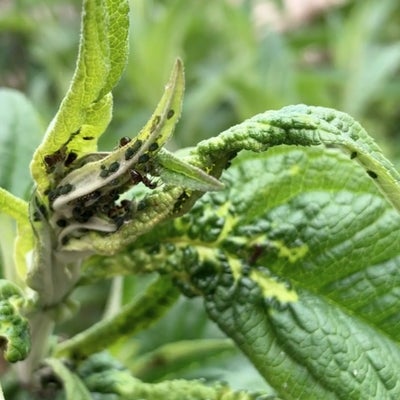
Quick facts
Common name - Melon-cotton aphid*
Scientific name - Aphis gossypii*
Plants affected - Buddleja (butterfly bush)
Main symptoms - Crinkled and curled leaves prone to yellowing
Most active - May
* = tentative identification
What’s the problem with my buddleja?
Buddleja leaves affected by aphids show unusual puckering and discolouration, caused by aphids feeding on the undersides of the leaves. Over time, the damage curls the leaf and can create pale patches that look similar to disease symptoms caused by a virus. However, this leaf damage is likely to be caused by the melon-cotton aphid, Aphis gossypii.

Symptoms of aphids on buddleja
- Crinkled, puckered and curled leaves that can look diseased
- Pale or yellow patches
- Aphid colonies may be found on the underside of leaves
- Shed skins indicate that aphids were previously present
Have you seen aphids or aphid damage on buddleja plants?
As part of our scientific research, we would like to know where buddleja aphid damage has been seen. If you’ve seen symptoms on buddleja plants, please take photos of the upper and lower sides of the leaves to submit to our survey. Please submit your records via our aphids on buddleja survey here(expected time to complete survey = two minutes).
If you have active aphid colonies, we may follow up to see if you can send us a sample to further help with our research on this relatively new find.
Thank you to everyone who has submitted records so far. Discover other sightings you can report to help our research here.
Background and research
In 2023, the RHS Gardening Advice Service received 58 reports of buddleja plants showing unusual symptoms. Samples of leaves were sent to the Food and Environment Research Agency (FERA) for to be tested for viruses, but none were detected, meaning the symptoms were most likely caused by damage from aphids feeding on the leaves.
In 2024, 67 reports were received, with aphids being found on the plants in most cases. RHS entomologists worked with aphid experts at the Rothamsted Insect Survey to obtain a tentative identification of melon-cotton aphid (Aphis gossypii) from a sample of buddleja at RHS Wisley.
Melon-cotton aphid is a generalist, which means it’s able to feed on many plant types, but it has mostly been limited to glasshouses in the UK. Due to the spike in reports over the last two years, our scientists are calling for sightings to be submitted. Reporting any sightings of aphids on buddleja will help us better understand its distribution and make further identifications.
How to manage aphids on buddleja
Although the leaf symptoms can look alarming, aphids are unlikely to have a significant impact on your buddleja’s health and vigour, so can often be tolerated.
If you see aphids on the plant, advice on how to manage them can be found here.




